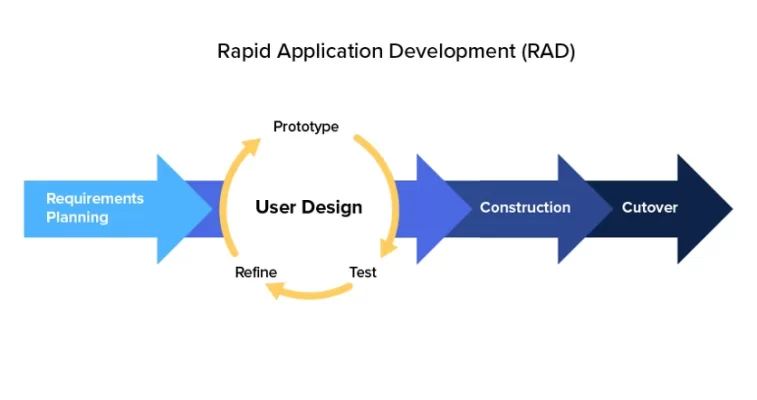RAD: What Does It Mean?
Built on development and testing as well as an agile methodology with little to no advance planning, Rapid Application Development (RAD) uses a RAD methodology for software development, emphasizing less on preparation than on the progress of a project.
Realizing that the traditional waterfall approach of development was useless led to the development paradigm RAD. One major disadvantage of the waterfall prototype is that, until it is under testing, it is impossible to change the main characteristics and specs of the software. You thus have apps either able or unable to satisfy your evolving needs.
One major disadvantage of the waterfall prototype is that, until it is under testing, it is impossible to change the main characteristics and specs of the software. You thus find programs either able or unable to satisfy your evolving needs.

The Phases in RAD (Rapid Application Development)
These four basic phases of fast application development have been constant even as RAD systems have changed.
Specify the Criteria
Development of rapid application distinguishes itself from conventional computer paradigms right away. It asks for a broad criteria instead of a thorough list of needs from end users. The overall framework of the requirements facilitates the inclusion of exact needs at different phases of the development process.
Most of the action occurs in a prototype form. Companies produce designs with varied functions and configurations as rapidly as they can, not following any one set of criteria. After that, the clients are shown the samples and asked to identify their likes and dislikes. Most of the time, these designs are hurried to serve particular purposes without enough finishing. It is natural; the only outcome produced is generated when the customer and the programmer agree on the final product at the completion stage.
Ask for Comments
Right now, comments on what’s good, bad, functional, and non-functional are sought. Feedback covers not only pure qualities but also visuals and frameworks. Prototyping starts with this considered feedback. These two cycles are repeated until a completed design satisfies the needs of the users as well as the programmers.
Finalization
The customer finishes here the parameters, operations, layout, and interface of the software. Reliability, accessibility, and maintainability are really important till you are delivering to the client.
RAD: Benefits and Drawbacks
Although app development seems like a great concept for all applications based on these motions, that is a little bit of a reach. Short-term projects and small groups would benefit from RAD software. It is not a cure-all, though, for all problems. Using fast application development has certain benefits and drawbacks as follows:
Why Is the RAD System of Significance?
For the following purposes, the Rapid Application Development (RAD) system is crucial:
When You Can Effectively Evaluate Your Designs
If you have multiple people who can offer real, accurate feedback on the prototypes you produce, rapid application development is the ideal model to follow. Rapid application development model-created prototypes depend on input from past implementations; hence reliable feedback from credible sources can be quite helpful.
When You Have a Plan
Though it can be pricey in some situations, rapid application development (RAD) is more cost-effective when compared to other engineering techniques. Retaining qualified staff members calls for paying them fairly. The good news is that, given the means, you can translate a concept from prototype to completed product even more quickly than most models.
When You Right Away Need a Task Completed
If you have a tight deadline, the best opportunity is a fast application development model. If you have to give something that functions under obligation, a RAD network could be the appropriate solution. Rapid application development code is your finest choice if you lack the means to complete a protracted configuration preparation and development period. Rapid application development uses an on-demand approach that sounds reasonable given rapid development that may pivot on a quarter.
FAQs
RAD Works How?
Emphasizing quick prototype launches and prototypes, Rapid Application Development (RAD) is an agile approach. Unlike the Waterfall method, RAD gives applications and user feedback top priority over strict preparation and requirements information.
Model of Fast Application Development
Built on the development and testing combined with an agile approach with little to no preparation, the Rapid Application Development (or RAD) concept generally emphasizes the evolution of a model above the organization of projects.


